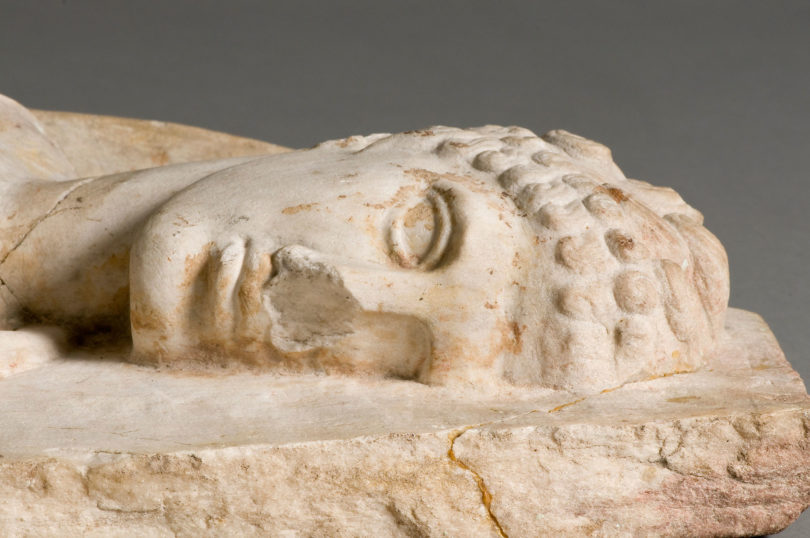The Georgia Museum of Art at the University of Georgia, in collaboration with UGA’s Franklin College of Arts and Sciences and the University of Mississippi Museum, will conduct “Object in Focus: The Orpheus Relief Project” through March 31.
The project involves the public exhibition and interdisciplinary study of the youthful figure of Hermes, the Greek messenger god, survived from a larger, three-figured composition depicting the god escorting Eurydice to the Underworld during her final parting from Orpheus. This larger composition, known as the Orpheus Relief, is one of the most celebrated examples of Greek sculpture from the High Classical period, ca. 450-400 B.C. The relief fragment is on display to the public in the Georgia Museum of Art’s Samuel H. Kress Gallery.
Mark Abbe, assistant professor of ancient art at UGA’s Lamar Dodd School of Art, is the project designer, which is a collaboration between UGA’s Center for Applied Isotope Studies, the department of chemistry, the department of classics and the Center for Archaeological Science.
Abbe expressed his excitement for “the opportunity to exhibit at the museum and on UGA’s campus this important, but little-known ancient work of art and to combine its study with the interdisciplinary educational aims of the university.” Students from many UGA departments are participating in the research, including those enrolled in Abbe’s mixed graduate/advanced undergraduate course “Overcoming Chromophobia: Color in Ancient Art.”
Three nearly complete Roman copies of this relief composition are preserved in Naples, Rome and Paris. They reproduce a lost Greek sculpture from the last decades of the fifth century B.C. in the elevated realistic style of the sculptures of the Parthenon. From the first century B.C. to the second century A.D., precise marble reproductions of such esteemed antique works of Greek art were produced for display in the private luxury villas of the Roman elite. The exhibited example, carved in Greek marble, is said to be from central Italy, around the Tarquinia area.
In antiquity, Greek and Roman marble sculpture was not pristine white but colorfully painted. The exhibited relief is the only replica of the Orpheus Relief known to preserve remains of ancient coloration, including visible red pigment on Hermes’ garments.
Jeff Speakman, associate director of the Center for Applied Isotope Studies, will conduct in situ non-destructive materials analysis by X-ray fluorescence spectroscopy and will direct the characterization of the relief’s white marble. Tina Salguero, assistant professor of chemistry, will characterize materials at the nano- and micro-length scales and apply a variety of scientific techniques to the minute amounts of pigments and binding media that remain on the surface of the relief.
Salguero said, “It is uncommon for a project to be so interdisciplinary, and I’m excited about the prospects of bringing together equal parts of cutting-edge science, art history and archaeology.”
The research may be tracked at the blog http://orpheusrelief.wordpress.com/. Project participants will present jointly the result of their interdisciplinary research at a public lecture and discussion at the Georgia Museum of Art March 28 at 5:30 p.m.
The relief has a documented historic provenance prior to the 1970 UNESCO conventions. It was acquired by David M. Robinson, president of the Archaeological Institute of America in Rome prior to 1948. The piece is now in the David M. Robinson Memorial Collection of Greek and Roman Art at the University of Mississippi Museum.
Museum Information
Partial support for the exhibitions and programs at the Georgia Museum of Art is provided by the Georgia Council for the Arts through appropriations of the Georgia General Assembly. The council is a partner agency of the National Endowment for the Arts. Individuals, foundations and corporations provide additional museum support through their gifts to the University of Georgia Foundation. The Georgia Museum of Art is located in the Performing and Visual Arts Complex on UGA’s East Campus. The address is 90 Carlton Street, Athens, Ga., 30602-6719. For more information, including hours, see www.georgiamuseum.org or call 706/542-GMOA (4662).







